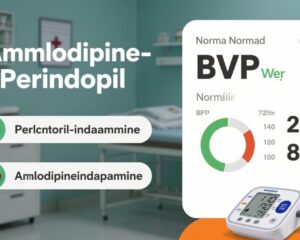Highlight
- A randomized clinical trial directly compared amiloride and spironolactone in resistant hypertension for the first time.
- Amiloride was shown to be noninferior to spironolactone in reducing home-measured systolic blood pressure after 12 weeks.
- The rates of achieving target systolic blood pressure (<130 mm Hg) were comparable between amiloride and spironolactone groups.
- Amiloride had a favorable safety profile with no gynecomastia cases and only one hyperkalemia-related discontinuation.
Study Background and Disease Burden
Resistant hypertension, defined as blood pressure that remains above target despite concurrent use of three antihypertensive agents of different classes, presents a significant clinical challenge. Persistent hypertension increases the risk of cardiovascular and renal complications, necessitating effective therapeutic strategies to improve blood pressure control. Spironolactone, a mineralocorticoid receptor antagonist, is currently recommended as a fourth-line agent for resistant hypertension due to its efficacy in blood pressure reduction. However, its use can be limited by side effects such as gynecomastia and hyperkalemia. Amiloride, a potassium-sparing diuretic that inhibits the epithelial sodium channel, has emerged as a potential alternative; yet, evidence from direct head-to-head randomized trials comparing these agents in resistant hypertension has been lacking until this recent study.
Study Design
A prospective, open-label, blinded end-point randomized clinical trial was conducted across 14 sites in South Korea from November 16, 2020, to February 29, 2024. The study enrolled 118 patients aged median 55 years (70% male) who exhibited resistant hypertension, evidenced by home-measured systolic blood pressure (SBP) of 130 mm Hg or greater despite a 4-week run-in period using a standardized fixed-dose triple medication regimen comprising an angiotensin receptor blocker, a calcium channel blocker, and a thiazide diuretic.
Participants were randomized in a 1:1 ratio to receive either spironolactone starting at 12.5 mg per day or amiloride starting at 5 mg per day. Dosages were titrated after 4 weeks — increased to 25 mg daily for spironolactone and 10 mg daily for amiloride — if home SBP remained elevated (≥130 mm Hg) and serum potassium levels were below 5.0 mmol/L.
The primary endpoint was the difference in change of home-measured SBP at week 12 between the two treatment groups. The noninferiority margin was pre-specified at -4.4 mm Hg for the lower bound of the confidence interval. Secondary endpoints included the proportion of patients achieving SBP under 130 mm Hg measured both at home and in office settings.
Key Findings
Baseline characteristics were well balanced, except a higher use of α-blockers in the amiloride group (8.6%) versus none in the spironolactone group. Mean baseline home SBP was 141.5 mm Hg (SD 7.9) for amiloride and 142.3 mm Hg (SD 8.5) for spironolactone groups.
After 12 weeks, mean home SBP decreased by 13.6 mm Hg (SD 8.6) in the amiloride group and 14.7 mm Hg (SD 11.0) in the spironolactone group. The between-group difference in SBP change was -0.68 mm Hg (90% CI, -3.50 to 2.14 mm Hg), satisfying the criterion for noninferiority of amiloride relative to spironolactone.
In terms of achieving target home SBP less than 130 mm Hg, 66.1% of patients on amiloride and 55.2% on spironolactone reached this goal, with no statistically significant difference. Office-measured SBP targets were achieved in 57.1% and 60.3% of patients in the amiloride and spironolactone groups, respectively.
Safety profile was favorable in both groups. Only one case of hyperkalemia-related treatment discontinuation occurred in the amiloride arm, and no cases of gynecomastia were reported in either group.
Expert Commentary
This trial provides clinically relevant evidence supporting amiloride as a viable alternative to spironolactone for resistant hypertension. The comparable efficacy in reducing SBP, coupled with a low incidence of adverse events, addresses some limitations posed by spironolactone’s side effects. Given the trial’s open-label design but with blinded endpoint assessment, and a well-defined noninferiority margin, the findings are robust and translate well to clinical practice, especially in patients who might be intolerant to spironolactone.
Mechanistically, while spironolactone blocks mineralocorticoid receptors influencing sodium retention and vascular remodeling, amiloride acts by directly inhibiting sodium channels in the distal nephron, reducing sodium reabsorption. The comparable blood pressure control observed suggests alternative pathways can effectively contribute to managing resistant hypertension.
Limitations include the relatively short follow-up period of 12 weeks and the study population predominantly from South Korea, which may affect generalizability to other ethnicities and longer-term outcomes. Further studies assessing cardiovascular events, renal function, and electrolyte management over extended periods will be valuable.
Conclusion
This randomized clinical trial demonstrates that amiloride is noninferior to spironolactone in lowering home-measured systolic blood pressure in patients with resistant hypertension. The comparable efficacy and favorable safety profile suggest amiloride could serve as an effective alternative for patients who cannot tolerate spironolactone or in whom spironolactone is contraindicated. These findings have important implications for expanding therapeutic options in resistant hypertension management and highlight the need for tailored treatment approaches based on patient-specific risk profiles.
References
Lee CJ, Ihm SH, Shin DH, Jeong JO, Kim JH, Chun KH, Ryu J, Lee HY, Choi S, Lee EM, Choi JH, Kim KI, Shin J, Pyun WB, Kim DH, Park S, Williams B. Spironolactone vs Amiloride for Resistant Hypertension: A Randomized Clinical Trial. JAMA. 2025 Jun 17;333(23):2073-2082. doi: 10.1001/jama.2025.5129. PMID: 40366680; PMCID: PMC12079568.
Additionally, current hypertension guidelines such as the 2024 American Heart Association Hypertension Guidelines provide context on resistant hypertension management and validate mineralocorticoid receptor antagonists as fourth-line agents.



